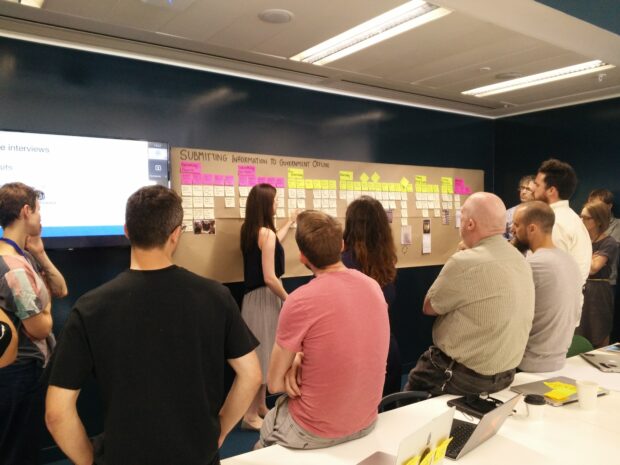
Last month we finished a discovery into collecting information from users. We focused on services without access to a software development team. This followed our previous work on discovering the next Government as a Platform component.
We’ve learned that if we can make it easy for service teams to improve and publish accessible forms, these teams will make things better for millions of people and save government a huge amount of money.
So we’re starting an alpha to explore what this might look like.
We’ll be partnering with smaller services to learn how to improve and publish accessible forms. We’ll also be talking to departments, government suppliers and the wider tech industry who are already looking at solutions to this problem. We’ll learn about the ways they’re solving this today and how we can scale up the best solutions across the whole of government.
The challenge
There are still a huge number of paper forms in government. The 5,078 PDFs and Word documents on GOV.UK alone are downloaded 36 million times each year.
Many forms have very high error rates. This results in caseworkers having to contact every person who submitted a form, to fix basic errors before the form can even be looked at. It’s clear that most of these problems come from the way the guidance is written, not the fact that the form is delivered using paper.
In general, we found poor experiences for users and high costs for government. Service teams, especially caseworkers and operations staff, want to improve things because they feel the pain of bad forms. But services with low transaction volumes can rarely justify the cost of a development team. And many larger services haven’t yet been prioritised for digital transformation.
The users of these services are being left behind.
The solution is much more than digitising forms
It’s easy to think that the solution is to make a forms builder, which allows service teams to get rid of all that costly data entry and illegible handwriting. But this doesn’t solve the most expensive problems, which come from people putting the wrong information on the form because it’s not clear to them what they’re being asked for.
We found that the main problems for users are:
- forms are hard to find in the first place
- poor guidance means people call for help before they start
- most forms don’t work for people with access needs
- users have to fill in too much unnecessary information or give the same information multiple times
- more than half the forms require evidence to be attached
These are the main challenges for service teams:
- eligibility is often determined too late in application processes
- error rates are very high (and errors are costly to resolve)
- costs of processing forms are not being measured
- forms are difficult to change
- caseworkers have little say in improving forms
Yes, making forms digital can open up opportunities for doing things better in the future. But it’s impossible to unlock the biggest benefits without improving the content and design first. You can’t do that with a digital tool alone.
Paper isn’t going to go away
Digitally excluded users will always need paper forms. Some services will always need wet signatures, although we do expect the number to decrease. And some forms will always need to be sent in the post along with physical evidence.
We need to find a way to provide paper forms and digital forms at the same time, or we’ll just end up doubling the number of forms available.
This will need to work at scale
If thousands of teams are going to improve and publish their forms, they’ll need the guidance and the tools to do this easily and quickly themselves.
We’ll partner with service teams and content designers across government to prototype and test which guidance and tools are most useful. We’ll find out which existing tools are fit for purpose rather than building new ones from scratch.
We'll ensure that any learnings from this alpha are reflected in our guidance and patterns. (We already publish form elements and guidance on form structure in the Service Manual.)
The opportunity
We’re starting an alpha looking at making it easy for service teams to improve and publish accessible forms alongside better guidance that helps users complete them successfully the first time.
If this works, in future it will be possible to prototype, build, test and iterate simple services without needing a development team. Just think what a content designer and a user researcher pairing could do with that.
It also potentially opens the door to thousands of currently non-digital services taking online payments, verifying identities, and using cross-government data. These things reduce the pain of supplying information that government already holds.
Some of this is a long way off. But we’re excited to get started.
Help us with our alpha
If you work in a service team using paper forms and you want to help us out with our alpha please get in touch. If you’re working on the same problem in your department we’d love to learn from your experience too.
Subscribe to this blog to hear the latest from the Government as a Platform teams.
Follow Will Myddelton and Ciara Green on Twitter.